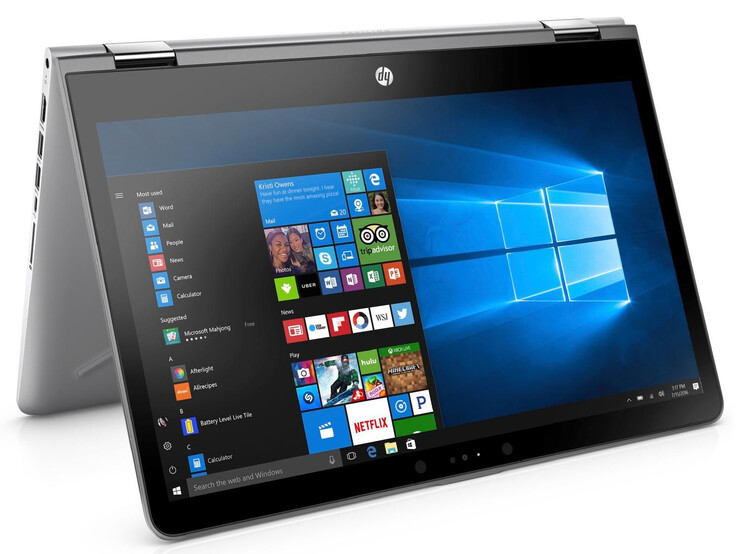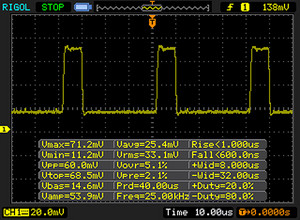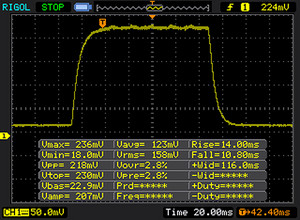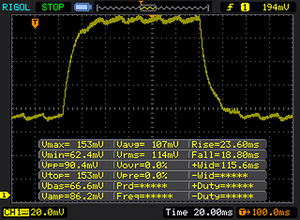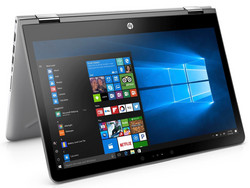Breve análisis del convertible HP Pavilion x360 14r (7200U, 940MX, FHD)
Top 10 Análisis
» Top 10 Portátiles Multimedia
» Top 10 Portátiles de Juego
» Top 10 Portátiles de Juego ligeros
» Top 10 Portátiles Asequibles de Oficina/Empresa
» Top 10 Portátiles de Juego Ligeros
» Top 10 Portátiles de Oficina/Empresa Premium
» Top 10 Estaciones de Trabajo
» Top 10 Subportátiles
» Top 10 Ultrabooks
» Top 10 Convertibles
» Top 10 Tablets
» Top 10 Tablets Windows
» Top 10 Tablets de menos de 250 Euros
» Top 10 Phablets (>5.5")
» Top 10 Smartphones
» Top 10 Smartphones (≤5")
» Top 10 Smartphones de menos de 300 Euros
» Top 10 Smartphones de menos de 120 Euros
» Top 10 Portátiles de menos de 1000 Euros
» Top 10 Portátiles de menos de 500 Euros
» Top 10 Portátiles de menos de 300 Euros
» Los Mejores Displays de Portátiles Analizados por Notebookcheck
Connectivity
| SD Card Reader | |
| average JPG Copy Test (av. of 3 runs) | |
| HP Pavilion x360 14-ba011ng (Toshiba Exceria Pro SDXC 64 GB UHS-II) | |
| Lenovo Yoga 510-14IKB (Toshiba Exceria Pro SDXC 64 GB UHS-II) | |
| Asus Zenbook Flip UX360UAK-BB351T (Toshiba Exceria Pro SDXC 64 GB UHS-II) | |
| maximum AS SSD Seq Read Test (1GB) | |
| HP Pavilion x360 14-ba011ng (Toshiba Exceria Pro SDXC 64 GB UHS-II) | |
| Lenovo Yoga 510-14IKB (Toshiba Exceria Pro SDXC 64 GB UHS-II) | |
| Asus Zenbook Flip UX360UAK-BB351T (Toshiba Exceria Pro SDXC 64 GB UHS-II) | |
| Networking | |
| iperf3 transmit AX12 | |
| Asus Zenbook Flip UX360UAK-BB351T | |
| Acer Spin 5 SP513-51 | |
| HP Pavilion x360 14-ba011ng | |
| iperf3 receive AX12 | |
| Asus Zenbook Flip UX360UAK-BB351T | |
| Acer Spin 5 SP513-51 | |
| HP Pavilion x360 14-ba011ng | |
| |||||||||||||||||||||||||
iluminación: 90 %
Brillo con batería: 240 cd/m²
Contraste: 1200:1 (Negro: 0.21 cd/m²)
ΔE ColorChecker Calman: 7.29 | ∀{0.5-29.43 Ø4.78}
ΔE Greyscale Calman: 7.48 | ∀{0.09-98 Ø5}
61% sRGB (Argyll 1.6.3 3D)
40% AdobeRGB 1998 (Argyll 1.6.3 3D)
43.33% AdobeRGB 1998 (Argyll 3D)
61.6% sRGB (Argyll 3D)
41.82% Display P3 (Argyll 3D)
Gamma: 2.45
CCT: 6953 K
| HP Pavilion x360 14-ba011ng IPS, 1920x1080, 14" | Lenovo Yoga 510-14IKB IPS, 1920x1080, 14" | Asus Zenbook Flip UX360UAK-BB351T IPS, 1920x1080, 13.3" | Acer Spin 5 SP513-51 IPS LED, 1920x1080, 13.3" | |
|---|---|---|---|---|
| Display | 1% | 51% | -4% | |
| Display P3 Coverage (%) | 41.82 | 41.78 0% | 64.1 53% | 39.99 -4% |
| sRGB Coverage (%) | 61.6 | 62.9 2% | 91.8 49% | 59.5 -3% |
| AdobeRGB 1998 Coverage (%) | 43.33 | 43.17 0% | 65.2 50% | 41.32 -5% |
| Response Times | -53% | -6% | -30% | |
| Response Time Grey 50% / Grey 80% * (ms) | 41 ? | 53 ? -29% | 36 ? 12% | 56 ? -37% |
| Response Time Black / White * (ms) | 22 ? | 39 ? -77% | 27 ? -23% | 27 ? -23% |
| PWM Frequency (Hz) | 25000 ? | 350 ? | 50 ? | |
| Screen | 2% | 26% | 12% | |
| Brightness middle (cd/m²) | 252 | 243 -4% | 368 46% | 245 -3% |
| Brightness (cd/m²) | 237 | 248 5% | 350 48% | 233 -2% |
| Brightness Distribution (%) | 90 | 91 1% | 87 -3% | 87 -3% |
| Black Level * (cd/m²) | 0.21 | 0.32 -52% | 0.29 -38% | 0.21 -0% |
| Contrast (:1) | 1200 | 759 -37% | 1269 6% | 1167 -3% |
| Colorchecker dE 2000 * | 7.29 | 5.44 25% | 5.26 28% | 4.2 42% |
| Colorchecker dE 2000 max. * | 17.55 | 9.73 45% | 8.78 50% | 8.75 50% |
| Greyscale dE 2000 * | 7.48 | 4.74 37% | 5.87 22% | 3.94 47% |
| Gamma | 2.45 90% | 2.38 92% | 2.42 91% | 2.66 83% |
| CCT | 6953 93% | 7799 83% | 6998 93% | 6096 107% |
| Color Space (Percent of AdobeRGB 1998) (%) | 40 | 39.6 -1% | 60 50% | 38 -5% |
| Color Space (Percent of sRGB) (%) | 61 | 62.5 2% | 92 51% | 59 -3% |
| Media total (Programa/Opciones) | -17% /
-6% | 24% /
27% | -7% /
3% |
* ... más pequeño es mejor
Parpadeo de Pantalla / PWM (Pulse-Width Modulation)
| Parpadeo de Pantalla / PWM detectado | 25000 Hz | ≤ 50 % de brillo | |
La retroiluminación del display parpadea a 25000 Hz (seguramente usa PWM - Pulse-Width Modulation) a un brillo del 50 % e inferior. Sobre este nivel de brillo no debería darse parpadeo / PWM. La frecuencia de 25000 Hz es bastante alta, por lo que la mayoría de gente sensible al parpadeo no debería ver parpadeo o tener fatiga visual. Comparación: 53 % de todos los dispositivos testados no usaron PWM para atenuar el display. Si se usó, medimos una media de 8111 (mínimo: 5 - máxmo: 343500) Hz. | |||
Tiempos de respuesta del display
| ↔ Tiempo de respuesta de Negro a Blanco | ||
|---|---|---|
| 22 ms ... subida ↗ y bajada ↘ combinada | ↗ 14 ms subida | |
| ↘ 10 ms bajada | ||
| La pantalla mostró buenos tiempos de respuesta en nuestros tests pero podría ser demasiado lenta para los jugones competitivos. En comparación, todos los dispositivos de prueba van de ##min### (mínimo) a 240 (máximo) ms. » 47 % de todos los dispositivos son mejores. Eso quiere decir que el tiempo de respuesta es similar al dispositivo testado medio (20.2 ms). | ||
| ↔ Tiempo de respuesta 50% Gris a 80% Gris | ||
| 41 ms ... subida ↗ y bajada ↘ combinada | ↗ 23 ms subida | |
| ↘ 18 ms bajada | ||
| La pantalla mostró tiempos de respuesta lentos en nuestros tests y podría ser demasiado lenta para los jugones. En comparación, todos los dispositivos de prueba van de ##min### (mínimo) a 636 (máximo) ms. » 64 % de todos los dispositivos son mejores. Eso quiere decir que el tiempo de respuesta es peor que la media (31.6 ms) de todos los dispositivos testados. | ||
| Cinebench R10 | |
| Rendering Multiple CPUs 32Bit | |
| HP Pavilion x360 14-ba011ng | |
| Asus Zenbook Flip UX360UAK-BB351T | |
| Rendering Single 32Bit | |
| HP Pavilion x360 14-ba011ng | |
| Asus Zenbook Flip UX360UAK-BB351T | |
| Geekbench 3 | |
| 32 Bit Multi-Core Score | |
| Asus Zenbook Flip UX360UAK-BB351T | |
| HP Pavilion x360 14-ba011ng | |
| 32 Bit Single-Core Score | |
| Asus Zenbook Flip UX360UAK-BB351T | |
| HP Pavilion x360 14-ba011ng | |
| Geekbench 4.0 - 64 Bit Multi-Core Score | |
| Asus Zenbook Flip UX360UAK-BB351T | |
| HP Pavilion x360 14-ba011ng | |
| Geekbench 4.4 | |
| 64 Bit Multi-Core Score | |
| HP Pavilion x360 14-ba011ng | |
| 64 Bit Single-Core Score | |
| HP Pavilion x360 14-ba011ng | |
| JetStream 1.1 - Total Score | |
| Asus Zenbook Flip UX360UAK-BB351T | |
| HP Pavilion x360 14-ba011ng | |
| Acer Spin 5 SP513-51 | |
| PCMark 8 Home Score Accelerated v2 | 3435 puntos | |
| PCMark 10 Score | 2756 puntos | |
ayuda | ||
| PCMark 8 - Home Score Accelerated v2 | |
| Asus Zenbook Flip UX360UAK-BB351T | |
| Lenovo Yoga 510-14IKB | |
| HP Pavilion x360 14-ba011ng | |
| Acer Spin 5 SP513-51 | |
| HP Pavilion x360 14-ba011ng Samsung CM871a MZNTY128HDHP | Lenovo Yoga 510-14IKB Samsung MZYTY256HDHP | Asus Zenbook Flip UX360UAK-BB351T Micron SSD 1100 (MTFDDAV256TBN) | |
|---|---|---|---|
| CrystalDiskMark 3.0 | 21% | 4% | |
| Read Seq (MB/s) | 519 | 518 0% | 478.4 -8% |
| Write Seq (MB/s) | 328.2 | 476.5 45% | 419.9 28% |
| Read 512 (MB/s) | 408.1 | 408 0% | 351.7 -14% |
| Write 512 (MB/s) | 170.2 | 274.5 61% | 294.2 73% |
| Read 4k (MB/s) | 35.29 | 35.66 1% | 24 -32% |
| Write 4k (MB/s) | 95.5 | 106.7 12% | 87 -9% |
| Read 4k QD32 (MB/s) | 398.4 | 368.7 -7% | 199.3 -50% |
| Write 4k QD32 (MB/s) | 161.2 | 246.3 53% | 232.4 44% |
| 3DMark 11 Performance | 2629 puntos | |
ayuda | ||
| 3DMark 11 - 1280x720 Performance GPU | |
| HP Pavilion x360 14-ba011ng | |
| Lenovo Yoga 510-14IKB | |
| Asus Zenbook Flip UX360UAK-BB351T | |
| Acer Spin 5 SP513-51 | |
| bajo | medio | alto | ultra | |
|---|---|---|---|---|
| BioShock Infinite (2013) | 91.8 | 51.7 | 42.2 | 14.9 |
| Prey (2017) | 58.3 | 21.9 | 18.2 | 15.6 |
| Rocket League (2017) | 87 | 31.3 | 20.7 | |
| Dirt 4 (2017) | 69 | 26.9 | 14.2 | 9.3 |
| Team Fortress 2 (2017) | 81.3 | 77.7 | 67 | 38.7 |
| Playerunknown's Battlegrounds (PUBG) (2017) | 40.5 | 15.2 | 11.9 | 7.8 |
| F1 2017 (2017) | 43 | 21 | 17 | 13 |
| Ark Survival Evolved (2017) | 25.8 | 7.3 |
Ruido
| Ocioso |
| 31.2 / 31.2 / 31.7 dB(A) |
| Carga |
| 38.4 / 42.1 dB(A) |
 | ||
30 dB silencioso 40 dB(A) audible 50 dB(A) ruidosamente alto |
||
min: | ||
(±) La temperatura máxima en la parte superior es de 44.7 °C / 112 F, frente a la media de 35.4 °C / 96 F, que oscila entre 19.6 y 60 °C para la clase Convertible.
(-) El fondo se calienta hasta un máximo de 50.8 °C / 123 F, frente a la media de 36.8 °C / 98 F
(+) En reposo, la temperatura media de la parte superior es de 26.4 °C / 80# F, frente a la media del dispositivo de 30.3 °C / 87 F.
(+) Los reposamanos y el panel táctil alcanzan como máximo la temperatura de la piel (32.4 °C / 90.3 F) y, por tanto, no están calientes.
(-) La temperatura media de la zona del reposamanos de dispositivos similares fue de 27.9 °C / 82.2 F (-4.5 °C / -8.1 F).
HP Pavilion x360 14-ba011ng análisis de audio
(-) | altavoces no muy altos (#69.3 dB)
Graves 100 - 315 Hz
(±) | lubina reducida - en promedio 13% inferior a la mediana
(+) | el bajo es lineal (6.8% delta a la frecuencia anterior)
Medios 400 - 2000 Hz
(+) | medios equilibrados - a sólo 2.1% de la mediana
(+) | los medios son lineales (4.2% delta a la frecuencia anterior)
Altos 2 - 16 kHz
(+) | máximos equilibrados - a sólo 1.8% de la mediana
(+) | los máximos son lineales (2.9% delta a la frecuencia anterior)
Total 100 - 16.000 Hz
(+) | el sonido global es lineal (13.4% de diferencia con la mediana)
En comparación con la misma clase
» 17% de todos los dispositivos probados de esta clase eran mejores, 4% similares, 79% peores
» El mejor tuvo un delta de 6%, la media fue 20%, el peor fue ###max##%
En comparación con todos los dispositivos probados
» 13% de todos los dispositivos probados eran mejores, 4% similares, 83% peores
» El mejor tuvo un delta de 4%, la media fue 24%, el peor fue ###max##%
Apple MacBook 12 (Early 2016) 1.1 GHz análisis de audio
(+) | los altavoces pueden reproducir a un volumen relativamente alto (#83.6 dB)
Graves 100 - 315 Hz
(±) | lubina reducida - en promedio 11.3% inferior a la mediana
(±) | la linealidad de los graves es media (14.2% delta a frecuencia anterior)
Medios 400 - 2000 Hz
(+) | medios equilibrados - a sólo 2.4% de la mediana
(+) | los medios son lineales (5.5% delta a la frecuencia anterior)
Altos 2 - 16 kHz
(+) | máximos equilibrados - a sólo 2% de la mediana
(+) | los máximos son lineales (4.5% delta a la frecuencia anterior)
Total 100 - 16.000 Hz
(+) | el sonido global es lineal (10.2% de diferencia con la mediana)
En comparación con la misma clase
» 7% de todos los dispositivos probados de esta clase eran mejores, 2% similares, 91% peores
» El mejor tuvo un delta de 5%, la media fue 18%, el peor fue ###max##%
En comparación con todos los dispositivos probados
» 4% de todos los dispositivos probados eran mejores, 1% similares, 94% peores
» El mejor tuvo un delta de 4%, la media fue 24%, el peor fue ###max##%
| Off / Standby | |
| Ocioso | |
| Carga |
|
Clave:
min: | |
| Battery Runtime - WiFi Websurfing | |
| Asus Zenbook Flip UX360UAK-BB351T | |
| Acer Spin 5 SP513-51 | |
| Lenovo Yoga 510-14IKB | |
| HP Pavilion x360 14-ba011ng | |
Pro
Contra
El HP Pavilion x360 14t es un convertible de 14". Está ampliamente equipado para los usos habituales en aplicaciones de oficina y Internet. Gracias a su GPU dedicada, el dispositivo hasta puede ejecutar juegos.
El HP Pavilion x360 14t está hecho principalmente para el uso doméstico.
Todo el sistema resulta muy rápido gracias a su rápido SSD, y la unidad de disco duro de 1 TB ofrece un montón de almacenamiento. Ambos dispositivos de almacenamiento se pueden actualizar y reemplazar, lo que requiere el desmontaje parcial de la carcasa.
El teclado es decente y está bien para los escritores prolíficos. El panel FHD IPS ofrece amplios ángulos de visión y una alta relación de contraste, por desgracia su brillo máximo es bastante bajo. Un dispositivo altamente portátil que muy probablemente va a usarse en diversas condiciones en muchos lugares debe ofrecer mucho más en este sentido.
El aguante de la batería en el mejor de los casos es mediocre. Al fin y al cabo, es un dispositivo portátil de 14". La garantía de 1 año tampoco es satisfactoria. Por su alto precio, habríamos esperado por lo menos 2 años.
Ésta es una versión acortada del análisis original. Puedes leer el análisis completo en inglés aquí.
HP Pavilion x360 14-ba011ng
- 08/29/2017 v6 (old)
Sascha Mölck




